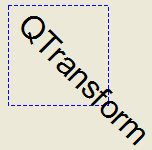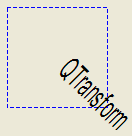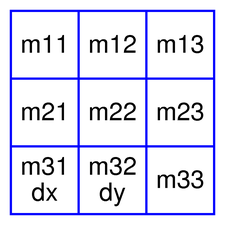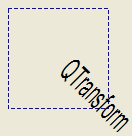PySide6.QtGui.QTransform¶
- class QTransform¶
The
QTransformclass specifies 2D transformations of a coordinate system. More…Synopsis¶
Methods¶
def
__init__()def
__reduce__()def
__repr__()def
adjoint()def
determinant()def
dx()def
dy()def
inverted()def
isAffine()def
isIdentity()def
isInvertible()def
isRotating()def
isScaling()def
isTranslating()def
m11()def
m12()def
m13()def
m21()def
m22()def
m23()def
m31()def
m32()def
m33()def
map()def
mapRect()def
mapToPolygon()def
__ne__()def
__mul__()def
__imul__()def
__add__()def
__iadd__()def
__sub__()def
__isub__()def
__div__()def
operator/=()def
__eq__()def
reset()def
rotate()def
rotateRadians()def
scale()def
setMatrix()def
shear()def
translate()def
transposed()def
type()
Static functions¶
def
fromScale()def
fromTranslate()def
quadToQuad()def
quadToSquare()def
squareToQuad()
Note
This documentation may contain snippets that were automatically translated from C++ to Python. We always welcome contributions to the snippet translation. If you see an issue with the translation, you can also let us know by creating a ticket on https:/bugreports.qt.io/projects/PYSIDE
Detailed Description¶
Warning
This section contains snippets that were automatically translated from C++ to Python and may contain errors.
A transformation specifies how to translate, scale, shear, rotate or project the coordinate system, and is typically used when rendering graphics.
A
QTransformobject can be built using thesetMatrix(),scale(),rotate(),translate()andshear()functions. Alternatively, it can be built by applyingbasic matrix operations. The matrix can also be defined when constructed, and it can be reset to the identity matrix (the default) using thereset()function.The
QTransformclass supports mapping of graphic primitives: A given point, line, polygon, region, or painter path can be mapped to the coordinate system defined by this matrix using themap()function. In case of a rectangle, its coordinates can be transformed using themapRect()function. A rectangle can also be transformed into a polygon (mapped to the coordinate system defined by this matrix), using themapToPolygon()function.QTransformprovides theisIdentity()function which returnstrueif the matrix is the identity matrix, and theisInvertible()function which returnstrueif the matrix is non-singular (i.e. AB = BA = I). Theinverted()function returns an inverted copy of this matrix if it is invertible (otherwise it returns the identity matrix), andadjoint()returns the matrix’s classical adjoint. In addition,QTransformprovides thedeterminant()function which returns the matrix’s determinant.Finally, the
QTransformclass supports matrix multiplication, addition and subtraction, and objects of the class can be streamed as well as compared.Rendering Graphics¶
When rendering graphics, the matrix defines the transformations but the actual transformation is performed by the drawing routines in
QPainter.By default,
QPainteroperates on the associated device’s own coordinate system. The standard coordinate system of aQPaintDevicehas its origin located at the top-left position. The x values increase to the right; y values increase downward. For a complete description, see the coordinate system documentation.QPainterhas functions to translate, scale, shear and rotate the coordinate system without using aQTransform. For example:
def paintEvent(self, arg__0): painter = QPainter(self) painter.setPen(QPen(Qt.GlobalColor.blue, 1, Qt.DashLine)) painter.drawRect(0, 0, 100, 100) painter.rotate(45) painter.setFont(QFont("Helvetica", 24)) painter.setPen(QPen(Qt.GlobalColor.black, 1)) painter.drawText(20, 10, "QTransform")
Although these functions are very convenient, it can be more efficient to build a
QTransformand callsetTransform()if you want to perform more than a single transform operation. For example:
def paintEvent(self, arg__0): painter = QPainter(self) painter.setPen(QPen(Qt.GlobalColor.blue, 1, Qt.DashLine)) painter.drawRect(0, 0, 100, 100) transform = QTransform() transform.translate(50, 50) transform.rotate(45) transform.scale(0.5, 1.0) painter.setTransform(transform) painter.setFont(QFont("Helvetica", 24)) painter.setPen(QPen(Qt.GlobalColor.black, 1)) painter.drawText(20, 10, "QTransform")
Basic Matrix Operations¶

A
QTransformobject contains a 3 x 3 matrix. Them31(dx) andm32(dy) elements specify horizontal and vertical translation. Them11andm22elements specify horizontal and vertical scaling. Them21andm12elements specify horizontal and vertical shearing. And finally, them13andm23elements specify horizontal and vertical projection, withm33as an additional projection factor.QTransformtransforms a point in the plane to another point using the following formulas:x' = m11x + m21y + dx y' = m22y + m12x + dy if not isAffine(): w' = m13x + m23y + m33 x' /= w' y' /= w'
The point (x, y) is the original point, and (x’, y’) is the transformed point. (x’, y’) can be transformed back to (x, y) by performing the same operation on the
inverted()matrix.The various matrix elements can be set when constructing the matrix, or by using the
setMatrix()function later on. They can also be manipulated using thetranslate(),rotate(),scale()andshear()convenience functions. The currently set values can be retrieved using them11(),m12(),m13(),m21(),m22(),m23(),m31(),m32(),m33(),dx()anddy()functions.Translation is the simplest transformation. Setting
dxanddywill move the coordinate systemdxunits along the X axis anddyunits along the Y axis. Scaling can be done by settingm11andm22. For example, settingm11to 2 andm22to 1.5 will double the height and increase the width by 50%. The identity matrix hasm11,m22, andm33set to 1 (all others are set to 0) mapping a point to itself. Shearing is controlled bym12andm21. Setting these elements to values different from zero will twist the coordinate system. Rotation is achieved by setting both the shearing factors and the scaling factors. Perspective transformation is achieved by setting both the projection factors and the scaling factors.Combining Transforms¶
Here’s the combined transformations example using basic matrix operations:

def paintEvent(self, arg__0): a = qDegreesToRadians(45.0) sina = sin(a) cosa = cos(a) scale = QTransform(0.5, 0, 0, 1.0, 0, 0) rotate = QTransform(cosa, sina, -sina, cosa, 0, 0) translate = QTransform(1, 0, 0, 1, 50.0, 50.0) transform = scale * rotate * translate painter = QPainter(self) painter.setPen(QPen(Qt.GlobalColor.blue, 1, Qt.DashLine)) painter.drawRect(0, 0, 100, 100) painter.setTransform(transform) painter.setFont(QFont("Helvetica", 24)) painter.setPen(QPen(Qt.GlobalColor.black, 1)) painter.drawText(20, 10, "QTransform")
The combined transform first scales each operand, then rotates it, and finally translates it, just as in the order in which the product of its factors is written. This means the point to which the transforms are applied is implicitly multiplied on the left with the transform to its right.
Relation to Matrix Notation¶
The matrix notation in
QTransformis the transpose of a commonly-taught convention which represents transforms and points as matrices and vectors. That convention multiplies its matrix on the left and column vector to the right. In other words, when several transforms are applied to a point, the right-most matrix acts directly on the vector first. Then the next matrix to the left acts on the result of the first operation - and so on. As a result, that convention multiplies the matrices that make up a composite transform in the reverse of the order inQTransform, as you can see inCombining Transforms. Transposing the matrices, and combining them to the right of a row vector that represents the point, lets the matrices of transforms appear, in their product, in the order in which we think of the transforms being applied to the point.See also
QPainterCoordinate SystemAffine Transformations ExampleTransformations Example- class TransformationType¶
Constant
Description
QTransform.TransformationType.TxNone
QTransform.TransformationType.TxTranslate
QTransform.TransformationType.TxScale
QTransform.TransformationType.TxRotate
QTransform.TransformationType.TxShear
QTransform.TransformationType.TxProject
- __init__()¶
Constructs an identity matrix.
All elements are set to zero except
m11andm22(specifying the scale) andm33which are set to 1.See also
- __init__(other)
- Parameters:
other –
QTransform
- __init__(h11, h12, h21, h22, dx, dy)
- Parameters:
h11 – float
h12 – float
h21 – float
h22 – float
dx – float
dy – float
Constructs a matrix with the elements,
m11,m12,m21,m22,dxanddy.See also
- __init__(h11, h12, h13, h21, h22, h23, h31, h32, h33)
- Parameters:
h11 – float
h12 – float
h13 – float
h21 – float
h22 – float
h23 – float
h31 – float
h32 – float
h33 – float
Constructs a matrix with the elements,
m11,m12,m13,m21,m22,m23,m31,m32,m33.See also
- __reduce__()¶
- Return type:
str
- __repr__()¶
- Return type:
str
- adjoint()¶
- Return type:
Returns the adjoint of this matrix.
- determinant()¶
- Return type:
float
Returns the matrix’s determinant.
- dx()¶
- Return type:
float
Returns the horizontal translation factor.
See also
m31()translate()Basic Matrix Operations- dy()¶
- Return type:
float
Returns the vertical translation factor.
See also
translate()Basic Matrix Operations- static fromScale(dx, dy)¶
- Parameters:
dx – float
dy – float
- Return type:
Creates a matrix which corresponds to a scaling of
sxhorizontally andsyvertically. This is the same asQTransform().scale(sx, sy) but slightly faster.- static fromTranslate(dx, dy)¶
- Parameters:
dx – float
dy – float
- Return type:
Creates a matrix which corresponds to a translation of
dxalong the x axis anddyalong the y axis. This is the same asQTransform().translate(dx, dy) but slightly faster.- inverted()¶
- Return type:
PyTuple
Returns an inverted copy of this matrix.
If the matrix is singular (not invertible), the returned matrix is the identity matrix. If
invertibleis valid (i.e. not 0), its value is set to true if the matrix is invertible, otherwise it is set to false.See also
- isAffine()¶
- Return type:
bool
Returns
trueif the matrix represent an affine transformation, otherwise returnsfalse.- isIdentity()¶
- Return type:
bool
Returns
trueif the matrix is the identity matrix, otherwise returnsfalse.See also
- isInvertible()¶
- Return type:
bool
Returns
trueif the matrix is invertible, otherwise returnsfalse.See also
- isRotating()¶
- Return type:
bool
Returns
trueif the matrix represents some kind of a rotating transformation, otherwise returnsfalse.Note
A rotation transformation of 180 degrees and/or 360 degrees is treated as a scaling transformation.
See also
- isScaling()¶
- Return type:
bool
Returns
trueif the matrix represents a scaling transformation, otherwise returnsfalse.See also
- isTranslating()¶
- Return type:
bool
Returns
trueif the matrix represents a translating transformation, otherwise returnsfalse.See also
- m11()¶
- Return type:
float
Returns the horizontal scaling factor.
See also
scale()Basic Matrix Operations- m12()¶
- Return type:
float
Returns the vertical shearing factor.
See also
shear()Basic Matrix Operations- m13()¶
- Return type:
float
Returns the horizontal projection factor.
See also
translate()Basic Matrix Operations- m21()¶
- Return type:
float
Returns the horizontal shearing factor.
See also
shear()Basic Matrix Operations- m22()¶
- Return type:
float
Returns the vertical scaling factor.
See also
scale()Basic Matrix Operations- m23()¶
- Return type:
float
Returns the vertical projection factor.
See also
translate()Basic Matrix Operations- m31()¶
- Return type:
float
Returns the horizontal translation factor.
See also
dx()translate()Basic Matrix Operations- m32()¶
- Return type:
float
Returns the vertical translation factor.
See also
dy()translate()Basic Matrix Operations- m33()¶
- Return type:
float
Returns the division factor.
See also
translate()Basic Matrix OperationsCreates and returns a QLineF object that is a copy of the given line,
l, mapped into the coordinate system defined by this matrix.Creates and returns a QLine object that is a copy of the given
line, mapped into the coordinate system defined by this matrix. Note that the transformed coordinates are rounded to the nearest integer.- map(p)
- Parameters:
p –
QPainterPath- Return type:
Creates and returns a
QPainterPathobject that is a copy of the givenpath, mapped into the coordinate system defined by this matrix.Creates and returns a QPoint object that is a copy of the given
point, mapped into the coordinate system defined by this matrix. Note that the transformed coordinates are rounded to the nearest integer.Creates and returns a QPointF object that is a copy of the given point,
p, mapped into the coordinate system defined by this matrix.Creates and returns a
QPolygonobject that is a copy of the givenpolygon, mapped into the coordinate system defined by this matrix. Note that the transformed coordinates are rounded to the nearest integer.Creates and returns a
QPolygonFobject that is a copy of the givenpolygon, mapped into the coordinate system defined by this matrix.Creates and returns a
QRegionobject that is a copy of the givenregion, mapped into the coordinate system defined by this matrix.Calling this method can be rather expensive if rotations or shearing are used.
- map(x, y)
- Parameters:
x – float
y – float
- Return type:
PyObject
Warning
This section contains snippets that were automatically translated from C++ to Python and may contain errors.
Maps the given coordinates
xandyinto the coordinate system defined by this matrix. The resulting values are put in *``tx`` and *``ty``, respectively.The coordinates are transformed using the following formulas:
x' = m11x + m21y + dx y' = m22y + m12x + dy if not isAffine(): w' = m13x + m23y + m33 x' /= w' y' /= w'
The point (x, y) is the original point, and (x’, y’) is the transformed point.
See also
Basic Matrix OperationsCreates and returns a QRect object that is a copy of the given
rectangle, mapped into the coordinate system defined by this matrix. Note that the transformed coordinates are rounded to the nearest integer.Warning
This section contains snippets that were automatically translated from C++ to Python and may contain errors.
Creates and returns a QRectF object that is a copy of the given
rectangle, mapped into the coordinate system defined by this matrix.The rectangle’s coordinates are transformed using the following formulas:
x' = m11x + m21y + dx y' = m22y + m12x + dy if not isAffine(): w' = m13x + m23y + m33 x' /= w' y' /= w'
If rotation or shearing has been specified, this function returns the bounding rectangle. To retrieve the exact region the given
rectanglemaps to, use themapToPolygon()function instead.See also
mapToPolygon()Basic Matrix OperationsWarning
This section contains snippets that were automatically translated from C++ to Python and may contain errors.
Creates and returns a
QPolygonrepresentation of the givenrectangle, mapped into the coordinate system defined by this matrix.The rectangle’s coordinates are transformed using the following formulas:
x' = m11x + m21y + dx y' = m22y + m12x + dy if not isAffine(): w' = m13x + m23y + m33 x' /= w' y' /= w'
Polygons and rectangles behave slightly differently when transformed (due to integer rounding), so
matrix.map(QPolygon(rectangle))is not always the same asmatrix.mapToPolygon(rectangle).See also
mapRect()Basic Matrix Operations- __ne__(matrix)¶
- Parameters:
matrix –
QTransform- Return type:
bool
Returns
trueif this matrix is not equal to the givenmatrix, otherwise returnsfalse.- __mul__(o)¶
- Parameters:
o –
QTransform- Return type:
Returns the result of multiplying this matrix by the given
matrix.Note that matrix multiplication is not commutative, i.e. a*b != b*a.
- __mul__(n)
- Parameters:
n – float
- Return type:
- __imul__(matrix)¶
- Parameters:
matrix –
QTransform- Return type:
Returns the result of multiplying this matrix by the given
matrix.- __imul__(div)
- Parameters:
div – float
- Return type:
Returns the result of performing an element-wise multiplication of this matrix with the given
scalar.- __add__(n)¶
- Parameters:
n – float
- Return type:
- __iadd__(div)¶
- Parameters:
div – float
- Return type:
Returns the matrix obtained by adding the given
scalarto each element of this matrix.- __sub__(n)¶
- Parameters:
n – float
- Return type:
- __isub__(div)¶
- Parameters:
div – float
- Return type:
Returns the matrix obtained by subtracting the given
scalarfrom each element of this matrix.- __div__(n)¶
- Parameters:
n – float
- Return type:
- operator/=(div)
- Parameters:
div – float
- Return type:
Returns the result of performing an element-wise division of this matrix by the given
scalar.- __eq__(matrix)¶
- Parameters:
matrix –
QTransform- Return type:
bool
Returns
trueif this matrix is equal to the givenmatrix, otherwise returnsfalse.- static quadToQuad(one, two, result)
- Parameters:
one –
QPolygonFtwo –
QPolygonFresult –
QTransform
- Return type:
bool
Creates a transformation matrix,
trans, that maps a four-sided polygon,one, to another four-sided polygon,two. Returnstrueif the transformation is possible; otherwise returns false.This is a convenience method combining
quadToSquare()andsquareToQuad()methods. It allows the input quad to be transformed into any other quad.See also
- static quadToSquare(quad, result)
- Parameters:
quad –
QPolygonFresult –
QTransform
- Return type:
bool
Creates a transformation matrix,
trans, that maps a four-sided polygon,quad, to a unit square. Returnstrueif the transformation is constructed or false if such a transformation does not exist.See also
- reset()¶
Resets the matrix to an identity matrix, i.e. all elements are set to zero, except
m11andm22(specifying the scale) andm33which are set to 1.See also
QTransform()isIdentity()Basic Matrix OperationsRotates the coordinate system counterclockwise by the given angle
aabout the specifiedaxisat distance 1024.0 from the screen and returns a reference to the matrix.Note that if you apply a
QTransformto a point defined in widget coordinates, the direction of the rotation will be clockwise because the y-axis points downwards.The angle is specified in degrees.
See also
- rotate(a, axis, distanceToPlane)
- Parameters:
a – float
axis –
AxisdistanceToPlane – float
- Return type:
Rotates the coordinate system counterclockwise by the given angle
aabout the specifiedaxisat distancedistanceToPlanefrom the screen and returns a reference to the matrix.Note that if you apply a
QTransformto a point defined in widget coordinates, the direction of the rotation will be clockwise because the y-axis points downwards.The angle is specified in degrees.
If
distanceToPlaneis zero, it will be ignored. This is suitable for implementing orthographic projections where the z coordinate should be dropped rather than projected.See also
Rotates the coordinate system counterclockwise by the given angle
aabout the specifiedaxisat distance 1024.0 from the screen and returns a reference to the matrix.Note that if you apply a
QTransformto a point defined in widget coordinates, the direction of the rotation will be clockwise because the y-axis points downwards.The angle is specified in radians.
See also
- rotateRadians(a, axis, distanceToPlane)
- Parameters:
a – float
axis –
AxisdistanceToPlane – float
- Return type:
Rotates the coordinate system counterclockwise by the given angle
aabout the specifiedaxisat distancedistanceToPlanefrom the screen and returns a reference to the matrix.Note that if you apply a
QTransformto a point defined in widget coordinates, the direction of the rotation will be clockwise because the y-axis points downwards.The angle is specified in radians.
If
distanceToPlaneis zero, it will be ignored. This is suitable for implementing orthographic projections where the z coordinate should be dropped rather than projected.See also
- scale(sx, sy)¶
- Parameters:
sx – float
sy – float
- Return type:
Scales the coordinate system by
sxhorizontally andsyvertically, and returns a reference to the matrix.See also
- setMatrix(m11, m12, m13, m21, m22, m23, m31, m32, m33)¶
- Parameters:
m11 – float
m12 – float
m13 – float
m21 – float
m22 – float
m23 – float
m31 – float
m32 – float
m33 – float
Sets the matrix elements to the specified values,
m11,m12,m13m21,m22,m23m31,m32andm33. Note that this function replaces the previous values.QTransformprovides thetranslate(),rotate(),scale()andshear()convenience functions to manipulate the various matrix elements based on the currently defined coordinate system.See also
QTransform()- shear(sh, sv)¶
- Parameters:
sh – float
sv – float
- Return type:
Shears the coordinate system by
shhorizontally andsvvertically, and returns a reference to the matrix.See also
- static squareToQuad(square, result)
- Parameters:
square –
QPolygonFresult –
QTransform
- Return type:
bool
Creates a transformation matrix,
trans, that maps a unit square to a four-sided polygon,quad. Returnstrueif the transformation is constructed or false if such a transformation does not exist.See also
- translate(dx, dy)¶
- Parameters:
dx – float
dy – float
- Return type:
Moves the coordinate system
dxalong the x axis anddyalong the y axis, and returns a reference to the matrix.See also
- transposed()¶
- Return type:
Returns the transpose of this matrix.
- type()¶
- Return type:
Returns the transformation type of this matrix.
The transformation type is the highest enumeration value capturing all of the matrix’s transformations. For example, if the matrix both scales and shears, the type would be
TxShear, becauseTxShearhas a higher enumeration value thanTxScale.Knowing the transformation type of a matrix is useful for optimization: you can often handle specific types more optimally than handling the generic case.